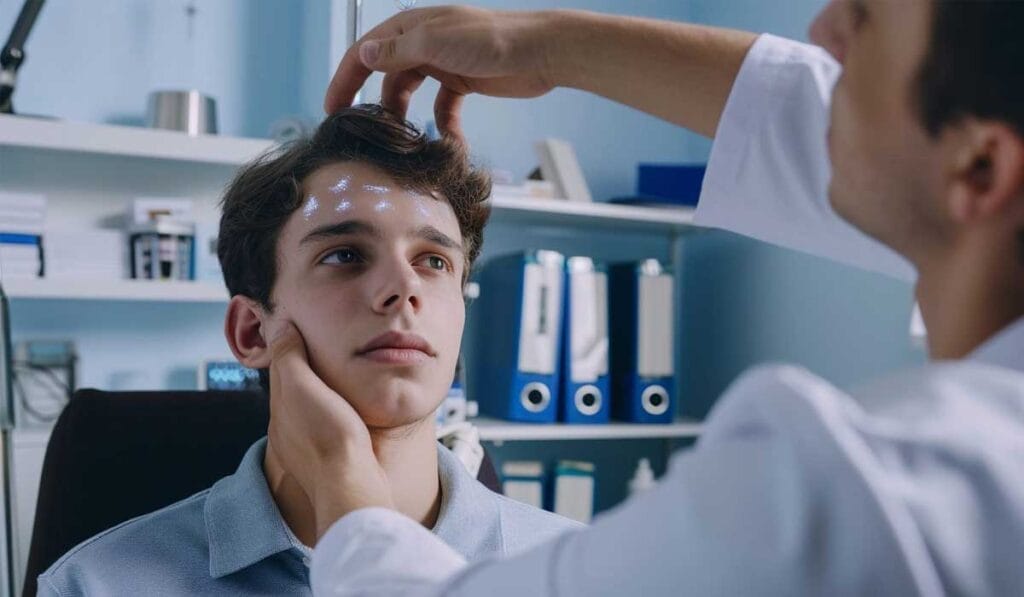The Ultimate Guide to Spotting the Symptoms of a Concussion
You just bumped your head, hard.
Maybe it was during a game, or perhaps an accidental tumble at home.
Now, you’re feeling off, and the worry kicks in—could this be a concussion?
A concussion is no small deal; it’s actually considered a mild traumatic brain injury.
But recognizing one can feel like piecing together a puzzle while the pieces keep slipping through your fingers.
Here’s an eye-opener: Every year, millions of people visit the emergency room because of head injuries; many suffer from concussions without even realizing it initially.
This article will guide you through managing a head knock—from spotting those sneaky symptoms to when you might need to pay a visit to healthcare professionals for that crucial CT scan or undergo neurological exams aimed at diagnosing brain bruises correctly.
Key Takeaways
- After a head injury, watch for concussion signs like headaches, dizziness, and confusion. These symptoms mean it’s time to see a doctor.
- Rest is crucial for healing from a concussion. This includes both physical rest and taking breaks from mental activities that strain the brain.
- Doctors use tools like neurological exams and imaging tests to check if someone has a concussion. They look at balance, memory, and even take special pictures of the brain.
- Slowly getting back to normal activities helps recovery. Start with light tasks and listen to your body. If something makes symptoms worse, take a step back.
- Protecting the head in everyday life and sports can prevent future concussions. Use helmets, follow safety rules, and understand how to spot concussion signs.
Identifying Signs of a Concussion

If you’ve bumped your head, watch out for signals like feeling dizzy or having trouble recalling things. These signs can whisper—or sometimes yell—that something’s not right inside your noggin.
Symptoms and indicators to observe
Ouch, hitting your head is no laughing matter. It’s like your brain decided to play pinball in there. But how do you know if it’s just a ding or something more serious?
Let’s dive into the signs and symptoms of a concussion that you should never ignore.
- Headaches that feel like someone’s tightening a band around your head – this isn’t just any headache; it feels different, more intense.
- Dizziness that makes the room spin – not the fun kind of spinning from playing dizzy bat.
- Nausea or vomiting – when your stomach joins the not-so-fun party.
- Confusion or feeling “foggy” – trying to think through pea soup fog.
- Double vision or blurry vision – when one of you suddenly becomes two.
- Sensitivity to light or noise – when even your dim lamp feels like a spotlight.
- Trouble with balance – feeling like you’re on a boat (but you’re not).
- Feeling unusually tired or drowsy – like someone hit the slow-motion button on you.
- Memory problems (like forgetting what happened right before or after the injury) – when your brain hits the pause button.
- Mood changes (irritability, sadness, more emotional than usual) – turning into a human rollercoaster.
If these symptoms sound familiar after taking a blow to the noggin, don’t brush them off as nothing.
These are clear signals from your body saying, “Hey, check this out.” So take it easy and get checked out by a doctor pronto because taking care of that brilliant brain of yours is top priority!
Immediate medical actions necessary
After a head thump, knowing what to do next is like finding your way in a dark room. First off, don’t just shake it off if you’ve taken a spill or bumped heads during soccer practice.
A quick trip to the emergency room might be your best bet to avoid trouble down the road. They’re equipped with tools like computerized tomography (CT) scans that peek into your noggin to see what’s up without making a single cut.
Think of it as superhero vision for doctors—they can spot brain injuries from miles away…well, not literally miles, but you get the idea.
Got knocked on the noggin and feeling woozy? It could be more than just seeing stars—concussions are sneaky beasts. Before you start popping Advil or Motrin IB for that headache, let’s put ice on that ego and call in the pros for an assessment.
Trained health professionals use their brains to understand yours better, assessing symptoms of concussion like confusion or loss of consciousness without missing a beat.
And hey—just because you feel okay now doesn’t mean game on; sometimes those pesky concussion symptoms decide to show up fashionably late.
A stitch in time saves nine…especially when it’s about your head.
Immediate Actions Following a Concussion

After you hit your head, the first thing to do is cool your jets—rest is key. Keep an eagle eye on how you’re feeling, because things can change fast.
Ensuring physical rest
Taking it easy is your new best friend after a head bump. Think of your brain like a tired toddler; it needs some serious downtime to get better.
You wouldn’t run a marathon with a broken leg, right? So, don’t expect your noggin to go full steam ahead when it’s healing from an injury.
Lounging on the couch isn’t just allowed, it’s recommended! Swap out those intense workouts for naps and quiet activities that don’t demand much from you mentally or physically.
Watching for symptom changes
Pay close attention to how your head feels in the days after an injury. Symptoms like headaches, dizziness, or trouble with your memory shouldn’t be brushed off as just a bump on the noggin.
These could signal that something more serious is going on inside your skull. It’s like being a detective in your own mystery novel – any small change might be a clue.
Keep a diary of what you experience: every headache, every night of tossing and turning, and times when words seem to play hide and seek in your brain. This isn’t just busy work. Your doctor can use this information to figure out the best way to get you back on track.
Think of it as teaming up for a mission where the goal is feeling like yourself again. Now let’s talk about tools that doctors use to see if there’s any bruising or swelling in that tough nut of yours….
Tools for Concussion Diagnosis

So, you bumped your head, and now things feel a bit off. Let’s talk about how doctors figure out if you have a concussion. They’ve got some cool tools up their sleeves—like detective gadgets for your brain! First up, they might do a neurological exam.
Think of it as a check-up where they test your balance, reflexes, and strength to see if everything is working right. Then there’s the cognitive test—it’s like a mini quiz for your brain to make sure you can think clearly and recall stuff.
Sometimes, if the doctor thinks it’s needed…
Conducting neurological exams
Doctors often use neurological exams to check on your nerves after a head injury. They will look at how your pupils react to light, test your strength, and see if you can feel things as you should.
It’s like being a car in for a tune-up—every part needs checking to make sure everything’s running smoothly.
During my first exam, the neurologist asked me to follow their finger with my eyes without moving my head. It felt weird, almost like a game where I couldn’t let the finger out of my sight.
They also tapped on my knees with a small hammer—you know, the kind that makes your leg kick without you meaning to? Yeah, that one. It was all to make sure my brain was talking right to the rest of me.
Your recovery track is as unique as your fingerprint.
Performing cognitive tests
After a bump on the noggin, your brain needs a check-up from the inside out. Doctors might suggest some brain teasers—not because they’re trying to be funny, but to see how your thinker is ticking.
Cognitive tests are like puzzles for your brain where no piece is too small. They look at memory loss, attention span, and reaction time. Think of it as a video game where you have to hit the right answers instead of zombies.
I once sat through these exams after taking an unplanned dive off my bike—it felt more like playing detective than patient. These tests showed how even though I could still binge-watch my favorite shows without forgetting plot lines,, concentrating on work tasks was as tough as solving Rubik’s Cube blindfolded.
It got me thinking: if our brains were computers, cognitive testing would be the ultimate diagnostic tool—no fancy equipment needed, just good old-fashioned question-and-answer sessions that cut straight to the chase about how well our internal wiring is working.
Considering imaging tests when needed
Sometimes, doctors suggest getting a peek inside your head—no magic required, just some high-tech scans. Think of CT scans and MRIs as superhero gadgets that help spot the hidden troubles like brain tissue damage or skull fractures.
These aren’t your everyday photos; they let docs see what’s invisible to the naked eye. So if you’ve had a nasty bump on the noggin’, these tests can be crucial. They’re especially handy when symptoms linger or worsen, making sure nothing serious like permanent brain damage is lurking.
Docs might go for an X-ray too, but that’s more to check if your neck decided to join the headache party with injuries like whiplash or cervical spine injury. Don’t worry about turning into a glow-in-the-dark version of yourself; radiation exposure from these scans is kept as low as possible.
It’s all about balancing risks and benefits—getting you back on track while keeping you safe.
Approaches to Concussion Treatment

After you bump your head, taking it easy isn’t just good advice—it’s the road to recovery. Let your brain take a break and ease back into daily tasks like reading or screen time slowly….
Emphasizing mental rest
Your brain needs a break after a concussion, just like an athlete needs rest after a big game. Think of your mind as a muscle that’s been pulled—you wouldn’t run on it; you’d let it heal.
So, give your thoughts some downtime. This means stepping back from activities that keep your neurons firing non-stop. Cut down on screen time, whether it’s smartphones or laptops.
Reading dense materials or solving complicated puzzles? Put them on hold too.
Rest is not idleness…
Ease into mental tasks slowly, listen to what your body tells you—it’s smart and knows when something isn’t right. If headaches flare up or you feel unusually tired while doing light mental activities, take it as a sign to pause and relax more.
Recovery varies for each person; patience plays key here.
Gradually resuming activities
After giving your brain a break, it’s time to slowly get moving again. The trick is not to jump back into your daily hustle too fast. Here’s how to ease back into the swing of things:
- Start with light physical activities. Think walking, not sprinting. And definitely hold off on anything that could shake your head around, like biking or running.
- Gradually increase your mental tasks. Reading and computer work are good examples. But if headaches start knocking or you feel dizzy, that’s your cue to pause.
- Listen to your body and brain. Feeling wiped out after a short walk? That’s okay! It means you need more rest.
- Add some mild stretching into your routine. It helps with neck pain and keeps you from getting too stiff.
- Try doing puzzles or brain games to gently nudge your cognitive processes back into gear without overdoing it.
- Stick to a solid sleep schedule to help improve sleeping patterns interrupted by the concussion.
- Break up screen time with rest breaks; those bright screens can be tough on a healing brain.
- Before jumping back into sports, get the green light from a professional familiar with sport-related concussions—no rushing this part!
- Keep tabs on how school or work tasks influence your symptoms, adjusting as needed.
- Eat well-balanced meals; good nutrition plays a big role in recovery from any injury, including concussions.
- Lastly, ease into social activities as they can be surprisingly draining after a concussion.
Taking these steps aids in healing and helps avoid setbacks like postconcussion syndrome or second impact syndrome—a type of re-injury before fully recovering from the first one that could lead to severe complications.
Everyone’s recovery journey looks different; what works for one may not suit another perfectly—so stay patient and keep communicating with healthcare providers about what feels right for you.
Handling pain and discomfort
As you start doing more, you might notice some pain or discomfort. It’s like your brain telling you to slow down a bit. Taking over-the-counter medicines like ibuprofen or Aleve can help ease the hurt.
For those achy moments that don’t quit, applying ice or a cozy heat pad can work wonders—kind of like a warm hug for your sore spots. And if turning your head makes you wince because of neck pain, consider using a soft neck brace.
It gives your muscles a break so they can heal without being pushed too hard.
Navigating the Recovery Journey

Bouncing back from a brain bump is like following a treasure map – you might not know what’s ahead, but sticking to the path gets you closer to the gold. Keep turning those pages for more secrets to uncover!
Stages of concussion recovery
Healing from a concussion feels like putting together a jigsaw puzzle — it takes time and patience. Each piece fits in its own way, just like every stage of recovery has its unique pace.
- Immediate Rest is Key:
After the accident, your brain needs rest. This means both physical and mental breaks. You might need to step back from sports, work, or school for a few days. Think of it as hitting the “pause” button on your favorite show. - Gradual Return to Activities:
Once symptoms start to fade, gently ease back into your daily routines. This doesn’t mean running a marathon right away but perhaps taking short walks or doing light household chores. Listen to your body—it’s the best coach you’ll ever have. - Monitoring Symptoms:
Keep an eye on how you’re feeling day by day. Headaches, dizziness, or trouble concentrating? These are signs you might be pushing too hard. It’s okay to slow down; recovery is not a race. - Managing Pain and Discomfort:
Over-the-counter pain relief can be helpful, but don’t forget to consult with a healthcare provider first. Sometimes remedies like icing the head or neck bring relief too. - Following Up with Healthcare Providers:
Regular check-ups with doctors or neurologists ensure you’re on the path to recovery. They might suggest cognitive tests or physical exams to measure your progress. - Emphasizing Sleep Patterns:
Good sleep is like medicine for the brain after a concussion. Try to keep a regular bedtime and wake up at the same time every day. - Optimizing Diet:
Eating well helps your brain heal faster. A balanced diet full of fruits, vegetables, and healthy fats gives your body the nutrients it needs during recovery. - Limiting Screen Time:
Too much screen time can strain your eyes and worsen symptoms like headaches and tiredness—so cutting back on electronic devices is wise. - Maintaining Mental Health:
Post-concussion syndrome can sometimes lead to depression or anxiety—talk about these feelings with someone you trust or seek professional help if needed. - Resuming Physical Activity Wisely:
When returning to sports or any physical activity, do so gradually under guidance from medical professionals who specialize in traumatic brain injuries—a clear plan helps prevent future concussions. - Prevention Is Always Better:
Learning how to avoid another concussion plays an important role in long-term health—wear protective gear during activities known for risks of head injuries and understand proper techniques in sports.
Each step towards recovery may feel small but keep in mind, slow and steady wins the race! The journey back may have twists and turns but getting through one phase at a time leads closer to feeling like yourself again.
Dietary role in recovery
Eating right plays a huge part in getting better after a concussion. Think of your brain like a car engine that needs the best fuel to run smoothly again. Foods rich in omega-3 fats, like salmon and walnuts, act like oil that keeps everything inside working well.
Fruits and vegetables loaded with antioxidants give your brain the boost it needs to heal from trauma.
Your journey doesn’t stop at medication; food is your ally in this battle.
Protein from chicken or tofu helps repair brain cells damaged during injury. Stay hydrated too—a well-lubricated machine always performs better. Skipping meals can make things worse, slowing down recovery.
So grab a plate, fill it with good stuff, and let each bite take you closer to feeling like yourself again.
Limiting screen time and electronics
Just like a well-balanced diet supports your body during recovery, cutting back on screen time is crucial for your brain. Staring at screens — whether it’s a smartphone, tablet, or computer — can strain your noggin when it’s trying to heal from a concussion.
Think of each text scrolled and every video watched as tiny hurdles for your brain. Your head needs fewer hurdles after an injury.
You might not realize it, but reducing screen use also battles insomnia and headaches — two common post-concussive symptoms that can prolong healing.
Swapping scrolling time with activities like reading physical books or engaging in light walks significantly eased my symptoms. It seems small, but limiting electronic devices helps more than you’d think in speeding up the journey to feeling like yourself again.
Strategies to Prevent Future Concussions

Ready to keep your head safe and sound? Let’s talk turkey on dodging those nasty knockouts. First up, suiting up in the right armor is key—think helmets that fit like a glove for biking, football, or even skateboarding.
It’s about more than just looking cool; it’s about keeping your noggin in one piece.
Next, knowledge is power—especially for staying on your feet. We’re talking making sure everyone from players to parents gets the 411 on what a concussion looks like and how to play it safe.
It’s all about playing smart—not hard—and knowing when to call time-out if things get hairy.
Adopting safety protocols and gear
Protecting your noggin is serious business, especially after a close call or if you’re just plain accident-prone. Gear up and follow safety steps to dodge another visit to the doc.
- Strap on a helmet for every ride, skate, or game. Whether it’s biking down the street or playing football, your head needs armor. Not all helmets are made equal though—look for one that fits snugly and meets safety standards set by organizations like the Consumer Product Safety Commission. I learned this the hard way after a skateboard tumble left me seeing stars.
- Use protective mouthguards in contact sports. A blow to the jaw can send shockwaves to your brain, potentially leading to concussive injuries. Mouthguards cushion the impact and can prevent more than just knocked-out teeth—they might save you from a traumatic brain injury (TBI).
- Equip proper padding for sports and activities. Knees, elbows, and even your torso need protection in rough-and-tumble sports. Pads should fit well and not restrict movement; otherwise, you’ll be tempted to leave them behind.
- Apply non-slip mats in slippery areas like the bathroom. Many head injuries happen at home due to falls. These mats are simple fixes that offer big rewards in preventing slips that could lead to hitting your head.
- Brighten up evening outdoor activities with reflective gear and lights. If cars can’t see you, the risk of accidents shoots up—especially true for runners and cyclists.
- Invest in quality footwear with good grip for everyday use as well as special activities—it makes a difference in stability and balance.
- Keep floors clutter-free to prevent trips and falls particularly if you have little ones or pets around who love leaving surprises underfoot.
- Engage in regular balance exercises; they strengthen your legs and core, improving overall stability which reduces fall risks.
- Follow road rules religiously when biking or skating; unpredictable moves confuse drivers leading to possible mishaps.
- Educate yourself on how to properly fall because yes, there’s a technique! Tuck and roll minimize impact—a useful tactic I picked up during martial arts training that once saved me during an icy sidewalk incident.
- Always secure loose rugs — these seemingly harmless home decorations are notorious for causing trips leading straight into furniture corners… or worse.
Taking these steps won’t just keep you safer; they’ll give everyone around you peace of mind.
Educating players and caregivers
Teaching players and those who take care of them about the risks of sports injuries, especially concussions, is a lot like putting on armor before heading into battle. Think of it as strapping on your helmet tightly—not just in games but in knowledge too.
Concussions aren’t just bumps on the head; they’re a type of mild traumatic brain injury that needs serious attention. By sharing insights on how concussions happen—whether from crashing onto the football field or tumbling off a bike—you give everyone tools to play safer.
It all starts with recognizing symptoms early and knowing when to shout “time-out” for medical help. Let’s break down what every coach, parent, and player should keep an eye out for: headaches that don’t quit, dizziness that feels like being on a merry-go-round, or even just feeling “off.” These signs are your cue to press pause and reach out for professional advice.
And here’s the kicker—learning this doesn’t require fancy equipment or big bucks; all you need is willingness to listen and learn. So let’s turn concussion management into a team sport where everyone knows how to protect their most valuable player: their brain.
Guidelines for Resuming Activities
Jumping back into your daily routine or sports after a concussion isn’t like hopping on a bike again. It’s more like balancing on a tightrope, where each step needs to be careful and steady.
First off, listen to your body and brain—they’re the real bosses here. If they say rest, you rest. And talking about sports? Well, there’s a playbook for that too. The rule is clear: no return without the green light from your doctor.
They’ve got the tools—like memory tests and balance checks—to tell if you’re ready or not.
So when it’s time to get back to class or hit the books hard at work, take it slow… don’t forget, rushing can make things worse. Keep an eye out for any lingering headache or dizziness because these are signs that you need to pump the brakes.
Following these steps isn’t just smart; it’s crucial for making sure one bad bump doesn’t lead to another.
Rules for returning to sports and academics
Before you hit the field or dive back into your studies, let’s talk safety and smarts. Getting back to sports and academics after a concussion takes careful steps. First off, doctors will give you the green light when it’s safe.
No rushing this one!
In sports, slowly ramping up is key. Start with light exercises—think walking, not sprinting. If symptoms like headaches come knocking, take a break. It’s your body saying, “Hey, slow down!” For academics, begin with shorter study times and breaks as needed.
Don’t push yourself through pain or discomfort to finish that assignment in one go.
Listen to your body and speak up if things feel off. And those tools for diagnosis? Keep them handy just in case symptoms linger longer than a cameo appearance—they’re crucial for monitoring your recovery journey.
And hey…wearing protective gear isn’t just making a fashion statement; it’s about putting your safety first for round two and beyond. Because getting knocked down doesn’t mean staying down—it means suiting up smarter next time around!
Checking for persistent symptoms
Keeping an eye out for lingering symptoms after a concussion is key in your recovery journey. You know your body best, so if headaches persist, concentration wavers, or sleep patterns are off, it’s crucial to take action.
These aren’t just minor inconveniences—they’re signals from your brain that something’s not right.
Healing isn’t linear; every day can feel like its own battle.
It might seem tempting to jump back into your routine—work, school, or sports—but patience here is a virtue. If you’ve been concussed, resuming activities too soon can sideline you longer than expected.
Let’s talk about what ‘too soon’ means. It involves more than just feeling okay—it means ensuring those pesky symptoms like dizziness and light sensitivity have waved the white flag.
If they stick around like unwanted guests at a party, it’s time to consult with professionals who specialize in neurology and rehabilitation again. They’re armed with tools like cognitive tests and may recommend nonsteroidal anti-inflammatory drugs (NSAIDs) to relieve pain without putting undue stress on your brain’s delicate healing process.
Conclusion
You’ve just walked through how to handle a bump on the noodle—from spotting those sneaky concussion signs to taking it easy on your brain and body. These steps aren’t rocket science, right? They’re all about keeping things low-key and listening closely to what your head’s telling you.
Now, think about putting these tips into play—could save a lot of headaches down the road, huh?
Easing back into your daily grind or getting back in the game needs patience and smart moves. No rush! It’s like piecing together a puzzle; every small step counts big time.
And hey, don’t forget that bit about safety gear and learning the ropes on staying safe? That’s your armor against future noggin knocks. What’s more empowering than knowing you’ve got this info in your toolkit?
So here’s to making good choices for your gray matter… because let’s face it, dealing with concussions is no joke—but handling them wisely? That’s something to strive for.
The next move is yours. Ready to tackle life with brain smarts?
FAQs
1. What should you do right after getting a bump on the noggin?
First off, if your head feels like it’s had a close encounter with a hammer after something like a motor vehicle accident or any knock to the noodle, take it seriously. Get yourself checked out by a doctor pronto. They’ll ask about what hit you and how hard, peek into your medical history, and might even say something fancy like “You’ve got yourself a mild traumatic brain injury.” Don’t just shake it off; getting an early diagnosis of concussion is key.
2. Can I just sleep it off if I think I have a concussion?
Hold your horses there! While catching Z’s might seem tempting when your head’s doing its best impression of a drum solo, it’s smart to get checked by a professional first. They can tell you whether that nap is safe or if you need more attention. Remember, concussions are sneaky beasts – they don’t always show their true colors right away.
3. When can I go back to playing sports after hitting my head?
Imagine this: You’re itching to get back in the game, but your brain’s waving red flags like it’s at an auction and spotting bargains left and right. Listen to those signals! The rule of thumb here is clear – no return to play until you’ve gotten the all-clear from someone who knows their stuff about concussions (like doctors). Jumping back in too soon isn’t winning any bravery awards; instead, it could land you on the bench longer.
4. Is popping pills for headache pain okay after suffering from mild TBI?
Ah, reaching for some Naprosyn or its buddies might seem like grabbing lifebuoy in choppy waters but hang tight before doing so! Your doc will be your best guide on this voyage through headache territory post-concussion because sometimes these meds can mask symptoms that need watching. Always check with them before diving into your medicine cabinet – safety first makes sure things don’t go south.

